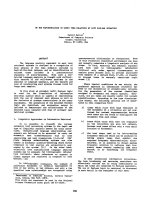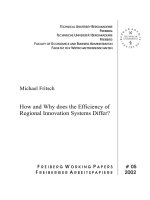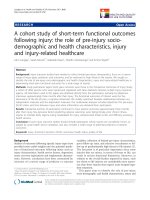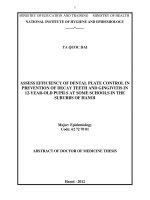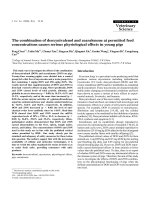LV thạc sỹ_Improve the efficiency of short term credit at VPBank dong do branch
Bạn đang xem bản rút gọn của tài liệu. Xem và tải ngay bản đầy đủ của tài liệu tại đây (229.56 KB, 54 trang )
NATIONAL ECONOMICS UNIVERSITY
ADVANCED EDUCATIONAL PROGRAM
*****************************
BACHELOR’S THESIS IN FINANCE
IMPROVING THE EFFICIENCY OF SHORT
– TERM CREDIT AT VP BANK – DONG DO BRANCH
HANOI 09 –
NATIONAL ECONOMICS UNIVERSITY
ADVANCED EDUCATIONAL PROGRAM
*****************************
BACHELOR’S THESIS IN FINANCE
IMPROVING THE EFFICIENCY OF SHORT
– TERM CREDIT AT VP BANK – DONG DO BRANCH
HANOI 09 –
ACKNOWLEDGEMENT
First of all, I would like to thank Professor …..
Finally, I offer my regards to all of those who supported me in any
respect during the completion of the thesis.
TABLE OF CONTENTS
NATIONAL ECONOMICS UNIVERSITY.......................................................1
ADVANCED EDUCATIONAL PROGRAM.....................................................1
NATIONAL ECONOMICS UNIVERSITY.......................................................2
ADVANCED EDUCATIONAL PROGRAM.....................................................2
1.4.2.2 THE QUANTITATIVE INDICATORS................................................12
FIGURE 2.1: STRUCTURE OF VPB DONG DO BRANCH.........................22
ABBREVIATIONS
ATM
Automatic Teller Machine
CIC
Credit Information Center
GDP
Gross Domestic Product
SBV
State Bank of Vietnam
SMES
Small and Medium Enterprises
VPB
Vietnam Prosperity Joint-stock Commercial Bank
CHAPTER I: INTRODUCTION
1.Rationale
In open market economy, the banks have to cope with strong
competition from foreign banks in term of human capital, quality of service or
the added value from banking services. Especially in this time, adopting
measures to ensure the quality of credit activity of banks cannot really be
placed on top, making the banks do not have high competitiveness, market
share of their increasingly shrinking to dominate the market today.
To better manage the lending process in terms of social economy
becomes a important mission to have adequate information about socioeconomic activities, capture customer needs and tastes to improve credit
quality. Improving the quality of lending is becoming increasingly necessary
and requires banks to implement measures to ensure the quality of credit. In
market economies, there is always the positive aspect and limitation, pose
challenges to banks that want to survive and develop, there must be a business
plan with economic efficiency, to ensure that costs and profits. But the
prerequisite set out with the banks now operating credit quality has to meet the
needs and tastes of consumers do not have appropriate development strategy
and create trust with customers to survive, sustainable development. And
during time practicing at VPBANK – Dong Do Branch , with the help of the
staff of the company and the help of MA Nguyen Thu Thuy, I decided on the
theme: "Enhancing the efficiency of short – term credit at VPBank-Dong Do
branch . "
2. Research Objective
The thesis focuses on the following main issues at VP Bank:
•Analysis of theoretical basis of effective credit and short-term credits
of commercial banks.
•Efficient situation analysis of short-term credit of VPB - Dong Do
branch from 2007 to now.
•Proposing solutions to improve the efficiency of short - term credit at
VPBank.
6
3. Scope of study
This thesis focuses on the result of consumer credit activities in VPB
Dong Do in 2007-2010 period.
4..Researh Methodology
The type of instrumentation and data collection procedures used is the
analyses of secondary sources such as:
• Statistical records: the bank’s annual reports, financial statements, etc.
• Textbooks: Commercial bank management, Bank credit…
• Other documents.
5.Structure of the research
The thesis includes three chapters:
- Chapter 1: The effect of credit and short-term credits of commercial
banks.
- Chapter 2: The effect of short-term credit in VPBank - Dong Do
branch.
- Chapter 3: Solutions for improving the efficiency of short - term
credit in VPBank - Dong Do Branch.
7
CHAPTER 1: THE EFFECT OF CREDIT AND SHORT – TERM
CREDITS OF COMMERCIAL BANK.
1.1. Overview of credit activity of commercial banks
1.1.1. Definition of credit activity
Credit is the most profitable activities, but the most risky for commercial
banks. This risk can cause damages, reduce the income of the bank. There are
many grants that losses could account for the majority of the capital, forcing banks
to bankruptcy. Therefore, banks must require close management to consider
carefully, estimate risks and profitability when deciding to give loan.
According to common sense, credit is the relationship of credit loans,
including lending and borrowing. Otherwise, credit is a temporary assignment of a
value in the form of objects or money from the owner to the user, after a certain
time to return with a larger.
The expression is reflected in three basic characteristics:
- Have the right to use a transfer of value from one person to another.
- The transfer is temporary in nature.
- When the return value of the property transferred must be accompanied
by an excess of value added is called profit.
* Principles of Bank Credit:
Credit activities of commercial banks based on a certain number of
principles to ensure the safety and profitability. These principles are embodied in
the provisions of state banks and commercial banks.
1. Customers must commit to repayment (principal) and interest for the
specified time: the bank's credit mainly derived mainly from customer deposits
and bank loans. Banks should be responsible for repayment of both principal and
interest as promised. So always ask the bank credits to comply with this
commitment. These conditions exist for banking and development.
1
2. Customers must commit to use for the purposes of credit agreement with
banks, not contrary to the provisions of law and other regulations of the bank
level. The law prescribes the scope of work for the bank. Besides, each bank can
have purpose and scope of individual operations. Funding purposes stated in the
credit agreement to ensure banks do not finance illegal activities and the funding
that is consistent with the bank's platform.
3. Bank financing is based on the plan (or project) to be effective.
Implementing this principle as a condition to make the first rule. Operational plan
effectively demonstrates the borrower's ability to recover investment capital and
profits to repay the bank. The bank's funding must be associated with the
formation of a borrower's assets. In the case of unsafe banks require borrowers to
have collateral to borrow.
1.1.2. Classification of credit activities of commercial banks
Our classify credit activities depends on customer requirements and
objectives of bank management. However, bank credit is mainly classified as
follows:
* Based on credit terms:
-Short-term Credit: A type of credit for less than a year and be used to
offset the shortage of working capital and other corporate short-term spending
needs of the individual.
- Medium Term Credit: A type of credit with a term of one year to five
years. Type of credit are primarily used for investment purchases of fixed assets,
improvement or renewal of equipment, technology, business expansion, new
construction projects are small and time rapid capital recovery.
- Providing long-term credit is a term of over five years. Long-term credit
mainly for long-term needs such as housing, equipment, vehicles and large-scale,
building new factories.
2
* Based on purpose of credit capital:
- Credit production and circulation of goods: the type of credit for
economic
actors
to
carry
out
production
and
circulation
of
goods
- Consumer Credit: Credit is granted for individuals to meet consumer needs such
as buying a house, car, speakers of other consumer goods.
* Based on the guaranteed loan:
- Unsecured credit (mortgage) is a type of credit without collateral, pledge
or guarantee by a third person, which the loan based on the prestige of the
individual customer.
- Credit security properties: the type of credit that the lender requires the
borrower to have collateral, pledge or guarantee from the third person.
* Based on form credit value:
- Credit money is those loans that form the value of credit granted in cash.
- Bank assets are those that form the credit value of credit granted by property-for
banks, credit forms mainly in the form of hire purchase.
* Based on loan method:
- Direct Credit: A form of credit which bank financing directly to customers
demand for loans, and borrowers repay the loan directly to banks
- Credit indirect form of credit is made through the acquisition of documents
which have arisen and also in the billing period.
* Based on the method of repayment:
- Credit payment: A type of credit that the customer must repay principal
and interest periodically. Type of credit is applied to the loan value and length of
time.
- Non-installment Credit: A type of credit that borrowers can pay a regular
basis as agreed. Type of credit is applicable to the loans of small value and the
short term.
3
- Credit refund request: A type of credit that borrowers can repay at any
time when income, the bank does not set a time limit, this method usually applied
to loans, overdraft, for credit card loans.
1.2. Short-term credit activities of commercial banks
1.2.1. The concept and characteristics of short-term credit operations
Short-term credit is a credit period of less than 12 month loans, often used
to supplement temporary shortage of working capital for businesses and
consumers daily needs of individuals.
The characteristics of short-term credit operations:
- Short-term Debt rotation cycle with production and business customers.
Short-term credit is to meet temporary shortages of working capital in production
and business processes of enterprises. The lending and debt collection always took
place at the beginning and end of production and business cycles. Bank loans often
arise when customer demand for capital to purchase supplies, materials, or cover
the cost of production, or purchase of goods (for trading enterprises). When goods
are sold, customer got sales, as well as debt recovery at the bank. Starting from
these characteristics, the banks lending period specified on the basis of the
production cycle - the borrower's business. Therefore, the payback in the shortterm loan is fast.
- The deadline for withdrawal of funds quickly, the risk of short-term loans
less loans and long-term interest rates lower than short-term lending rates for
medium and long term.
- This type of loan abundant Bank provides increasingly diverse methods
for short-term loans, including loans each, lending limits, overdraft loans, loan
transfer ... This has to meet the diverse needs of customers, and help banks reduce
risks, avoid the risk of non-system.
- Short-term credit operations of major banks. This stems from the reasons:
Activities are receiving short-term funding activities of the major commercial
banks, in addition to the provisions of the Central Bank of the maximum
4
percentage of capital resources short-term capital is used for medium and long
term. So, with the appropriate interest rate, term and provisions of the Central
Bank, short-term lending activity is one of the major activities of commercial
banks.
Thus the need for short-term credit operations comes from two reasons: the shortterm capital needs of businesses and business characteristics of commercial banks.
1.2.2 The role of short-term credit
Short-term lending by commercial banks is of paramount importance for
the development of the economy. Short-term loans have contributed to stability,
maintain and expand manufacturing business - for business, improving the lives of
individuals and households. When it comes to short-term loan, it is important that
we pay attention is the effect of the loan. The effect of loans reflects the
investment performance of the manufacturing business and show business stability
and profitability of the bank.
1.2.2.1. For economy
Banks in the economy work as a business enterprise on the monetary field.
As a financial intermediary, it is channeling funds from capital surplus to areas
where lack of capital and operating effectively in the economy. The transmission
channels which can over financial markets that the credit operation and long-term,
but it was strong competition of the non-bank financial institutions participating in
this market such as: insurance companies, investment funds, financial companies
or a money market channels and mobilization of funds and other short-term
valuable papers. These market operations are flexible and provide a large capital
for the economy. Thus, short-term credit is growing strongly.
1.2.2.2 For businesses
-Short-term credit is timely additional resources for short-term capital needs
of the business. This fund helps businesses continue to produce business process,
or helping enterprises solve temporary difficulties financially. In many cases, bank
loans are also cost-effective solutions for the enterprise, enabling businesses to
5
catch business opportunities, take advantage of opportunities to develop
production.
− Short-term credit and motivation: factors that stimulate the production and
business enterprises. The lending requirements in short-term gives pressure to
businesses to become effective. When businesses borrow from banks, the
pressures they are subject to the principal and interest will be paid when due,
precisely because of this, businesses will have to try and fast turnaround of capital
seeking opportunities for business best.
Thus, short-term credit not only help businesses obtain additional sources
of working capital but also the motivation to help businesses do business
effectively, before it was to pay the loan then is to develop business industry.
1.2.2.3 For the existence and development of commercial bank
Credit activities in general and in particular short-term credit is the basic
operation, major commercial bank, it is profitable primarily for commercial banks.
It is a tool to make profit and risk prevention for the bank. During the operation of
banks, bank executives pay attention to such issues is to create revenue to cover
the costs. On the other hand, it helps to ensure the liquidity of banks. Short-term
credit can help administrators solve this problem.
1.2.3 The case of short-term bank loans
1.2.3.1 Commercial Bank for short-term loans to finance current assets
Commercial Bank lending to enterprises Short-term capital to finance
current assets, which ensure both safety and profitability for the operation of
commercial banks, while ensuring a reasonable level of capital expenditures for
businesses. The specific case:
- Commercial Bank loan to finance additional capital requirements for
production and business under this form, the capital of the banks involved only
one stage in the production process - the business of business. Business loans to
buy raw materials, tools equipment, increase reserves and will pay when selling
goods.
6
- Commercial Bank Lending to serve the buying and selling goods, the
operation export and import of commercial enterprises.
Business purchases can be lack of funds. Banks can lend to and will
purchase the debt while selling businesses. Banks can lend to businesses in the
form of loans made each time, lending the L / C, bill discount, factoring.
This is a lending operation is of paramount importance, it helps to keep the
production process - the business of the enterprise took place seamlessly.
COMMERCIAL BANK possible business risks when the goods are not sold.
1.2.3.2 Commercial Bank for short-term loans to finance fixed assets
Typically, the commercial banks give short-term borrowings to finance
current assets. But in some special cases, the object of financing short-term
lending activities of commercial banks is fixed assets. In this case, can not speak
to the compatibility between the duration of the mobilization of resources and
assets, but only consider the business reasons why the use of short term loans to
finance fixed assets. The reason that borrowers are temporary lack of funds,
maintain a reasonable capital structure, financial leverage. From the reasons on
which customers can choose from short-term loans to finance fixed assets, not
necessarily the medium and long term loans.
Specifically, in case a temporary lack of business investment in machinery
and equipment as fixed assets, but business is still able to return in the short term,
the short-term solution is more effective than with medium and long term loans.
Short-term loans to help businesses take advantage of the benefits of the use of
debt quickly get the funds needed to pay the cost of capital lower than the medium
and long term loans.
Short-term loans also have a major advantage is that nature in time with
reasonable cost, while businesses not yet ready for collection but are in need of
long-term use of money. Short-term borrowings procedures simpler medium and
long term, saving businesses time to review the loan application stage, the stage of
contracting and disbursement process.
7
Thus it can be said for short-term loans are not only the method of
financing major assets, but also an effective solution in some cases.
1.3. The method is mainly short-term loan
1.3.1 Loans and overdrafts
Overdraft lending is the bank that allows the borrower to be more dominant
(over) on deposit to pay her a certain limit and for a period of time. This limit is
called the overdraft limit.
To be overdrawn, the customers to apply for a bank overdraft facility and
the overdraft limit (which may have to pay a commitment fee to the bank). During
the operation, customers can sign checks, an authorized spending, purchasing
cards ... exceeds the deposit balance to pay (the overdraft limit). When customers
enter the amount on deposit accounts, banks will collect the principal and interest.
Overdraft lending generally occurs when customers do not have the
appropriate size and duration of income and expenses. Therefore, these types of
loans make it easier for customers in the checkout process.
The amount of interest that customers pay will be based on interest, time
and amount of overdraft. Specifically:
Amount of interest paid = interest rate on overdraft x overdraft Time
x Amount of money.
Overdraft is a form of short-term credit, flexible and simple procedures.
largely unsecured, may be issued for both commercial and personal days in the
month a few months of the year for salaries, expenses and accounts payable,
purchasing ... This form is generally used only for customers with reliable, regular
income and short-period income, long-term relationship with the bank.
1.3.2 Each directly loans
Direct lending is a form for each loan is relatively common for the bank's
customers have no need to borrow frequently, without access to the overdraft limit
granted. These customers use the equity and trade credit is essential, just as
8
seasonal demand, or to expand production a special new bank loans, bank capital
is only involved in a certain stage of production and business cycles.
Each customer must make a loan and the bank plans to use debt. Bank will
analyze the customer and signed for loans, determine the size of loans,
disbursement period, repayment period, interest rates and conditions to ensure, if
necessary. Each loan is separated into different records.
Number of loans = capital demand loan production business - equity
participation - Other sources involved
As each debt maturities in the contract, the bank will collect the principal
and interest. In the process customers use the loan, the bank will aim to control
and effective use, if signs of breach of contract, the bank can recover the debt
before maturity, or overdue. Interest rates can be fixed or floating interest from
time to time.
Lending each relatively simple. Bank can control each separate loan. Loans
based on the value of collateral.
1.3.3 Lending limits
This is a business whereby the bank credit agreement for credit customers.
Credit limit can be calculated for the whole period or late period. That balance is
calculated at the time of calculation.
Credit limit granted on the basis of production and business plans, capital
requirements and borrowing requirements of customers. Bank estimates of the
credit line for enterprises based on production, business plans and borrowing
requirements of customers, the maximum lending rate on the total value of
collateral, the ability to source bank's capital.
During the period, customers can take loans to pay many times, but debt
does not exceed credit limit. In some cases banking regulations limit the last
period. Outstanding in the period may exceed the limit. But by the end of period,
customers pay outstanding debts to reduce the last period should not exceed the
limit.
9
Each loan customers need only to present plans for use of the loan, submit
documents proving the purchase of goods or services and if requested borrowing.
After checking the legality and validity of documents, the bank will disburse to the
client.
This is a convenient form of loans to customers who borrow regularly,
participating in regular loans to business and production process. In the banking
business is no fixed repayment date. When income comes to customers, the bank
will collect the debt, thus actively managed funds for clients. But by the time the
loan is not separated into specific maturities to bank debt difficult to control the
effect of each loan. Banks can only detect the problem when customers submit
financial statements, or long outstanding unabated.
1.4 The effect of short-term credit
1.4.1 The concept of effective short-term credits of commercial banks
Like other companies in the business, banks are focused on improving
performance in general, including raising the efficiency of credit. On the corner of
Commercial Bank, the credit effectively only be considered under the criteria of
safety and profitability for banks. Profitability is operating income due to provide
credit and this income must be greater than the costs. On the other hand effective
credit must also ensure the safe. On the point of economic efficiency and
effectiveness of credit that bring profits from credit operations because the bank
can benefit from the credit means the credit to be effective, also means that
customers of banks operating in business efficiency, profit to repay the bank. For
society, the credit performance will contribute to the implementation of policies or
goals of economic development of the state, creating a favorable environment for
all members of the development.
Thus, the credit effectively means the ability to respond appropriately to
most of the capital needs of customers on the basis of safety and profitability for
banks.
10
The effect of credit is a specific concept has just abstract. Can use an index
number formula and to specify the efficiency of credit, but for those unable to
quantify is the use of indicators.
Due to limitations of the research focused on the banking concept of
efficiency should be understood from a credit perspective of the bank and be
specific with the indicators of qualitative and quantitative.
1.4.2 The basic criteria evaluate the effectiveness of credit
1.4.2.1 The qualitative indicators
This is a group of criteria for assessing the effectiveness of credit on a legal
basis; to comply with regulations and business processes of commercial banks; to
comply with contractual commitments for loans (credit contract use).
- Base on legal grounds, lending activity effective if compliance with state
laws, regulations for the loan, the guiding documents of the Government and the
State Bank and its legal other relevant laws.
- Base on the basis of regulations of individual lending commercial bank,
lending activities is effectively complying with regulations and business processes
for loan. Since these have their own characteristics, most banks are offering
research and provided the most appropriate lending institutions. Specifically, the
bank created credit manuals, which provide the concepts, regulations, procedures
and specific guidance for bank staff. The provisions in the lending process is
applied to each specific case the borrowing in each commercial bank is to make
the loan effective. Therefore, compliance processes is a critical condition, the
premise of a loan to be effective.
- Base on the basis of loan contracts, while conducting lending activities,
banks and customers will establish a credit agreement. The credit agreement will
stipulate details of the important factors such as the loan term, loan purpose, loan
amount and mode of repayment of principal, interest ... and is expressed in the
form of commitment. A loan is considered effective when it is done properly
signed commitments in the credit agreement.
11
The group of indicators mentioned above may reflect a portion of loan
effectiveness. These are almost mandatory criteria must be met for a loan is
considered to be effective. However, to consider specific, carefully planned and
comprehensive, we need to consider the quantitative targets.
1.4.2.2 The quantitative indicators
Group’s quantitative indicators reflect the face amount of the loan, through
the analysis of indicators, calculation and comparison. The team of quantitative
indicators includes:
a. Group of indicators reflecting the scope for short-term loans:
-The first indicator:
The proportion of loans short-term credit = Outstanding short-term loans/
Total outstanding credit
This indicator reflects the scale of short-term credit banks.
-The second indicator:
The growth short – term credit
= (Outstanding short-term credit next
year / Short-term credit outstanding year previous)*100%-100%
This indicator reflects the growth of outstanding loans over the years. This
criterion is considered in terms of expansion of short-term credit banks.
b. Group targets reflect safety:
-The first indicator:
The rate of overdue debts = * 100%
The rate of overdue debt is an important indicator to assess the safety of
short-term credit as well as evaluate the effectiveness of the credit banks. Once the
banks have too many overdue debts, which banks are at risk not refund amounts
already lent, causing congestion and affect the payment of capital raised and cause
loss of confidence in population would affect the bank's activities to business
performance, efficiency low credit, declining competitiveness. Therefore this rate
as low as possible.
12
-The second indicator:
The rate of short-term bad debt = * 100%
The customer's debt in credit institutions are classified by groups and debt
from a group → group 5 with increasing degree of risk. Accordingly, the debts of
Group 3 → 5 group called the potential bad debt risk of capital loss to the bank. So
bad debt of banks showed lower banks lower credit quality.
-The third indicator:
Indicator outstanding Short-term loans with collateral = (Outstanding shortterm credit with collateral / Outstanding short-term)*100%
The effect of credit must include the safety factor, outstanding short-term
credit guarantee asset contributing to the safety of such credits. Most bank loans
must be secured assets as collateral to limit the loss of bank capital. In the case of
bank customers do not repay the loan, then, the bank will sell the collateral to
offset that loss. So, it helps to increase the efficiency of bank credit to the lending
limit for loans without collateral.
a. Group indicators reflecting the level of profitability:
The proportion of income from short-term lending activity = (Income from
short-term lending activity / Income from credit operations)*100%
The analysis of the proportion of income from short-term lending activities
to help us assess the profitability of short-term lending activity in the total income
from credit activities of banks, which shows the importance its important to take
measures which improve the efficiency of this operation.
1.4.3 The need to improve the efficiency of short-term credit activities
of commercial banks.
Short-term credits Short-term loans is one of the most important activities
of commercial banks, the profitable operation of the bank, it also has a small
impact to all aspects other activities of the bank.
In addition, short-term lending activities of commercial banks not only
affect the bank itself, but it also affects many other subjects of the economy. Help
your business and production processes, consumption of individuals, businesses
13
place seamless, uninterrupted. So, short-term lending activities of commercial
banks have great influence on the whole economy. Improving the effectiveness of
short-term loans not only help banks profitable, safe but also meet the capital
needs for the economy, helping economic development advantages.
Also by raising the efficiency of short-term lending bank, will help banks
survive in a sustainable way, strengthening relationships with partners and
increase competitiveness. For the economy, improving the effectiveness of shortterm lending bank will help improve the efficiency of capital use in the economy,
encourage savings and investment, promote economic development.
Thus, improving the efficiency of short-term loans is necessary objective,
firstly because of the existence and development of commercial banks, and for the
development of the economy.
1.4.4 Factors affecting the effectiveness of short-term loans of
commercial banks
Short-term lending activities take place between two entities as commercial
banks and their customers. In addition, lending activity are in an environment that
is regulated by law, the macro-economic policies... are the conditions of the
economy. So to get a loan with a high efficiency are necessary conditions from the
parties concerned.
1.4.4.1 To the Bank The ability to assess loan
-In the process of bank credit, loan appraisal is the first step and important.
Evaluation is the assessment, verification, prediction of accuracy, safety and
efficacy of a credit contract. The results of the evaluation process will be used to
decide whether to make loans or not. Although it is impossible to avoid all errors,
but do well this process will set the stage for the full recovery of principal and
interest fully and on time. Evaluation process not only requires compliance with
strict safety records and information but also require professional level and
predictability of flexible staff. For short-term lending, characterized by "frequent"
14
and timely appraisal should also require rapid response to customer demand for
capital, and to ensure the accuracy and safety.
Credit policy
Credit policies of commercial banks is a system that reflects the text of a
platform of bank financing, to provide general guidance for credit officers and
bank employees, increasing specialization in the analysis credit, creating a
consensus in credit operations to minimize risk and improve profitability.
An appropriate credit policies will enable lending activities of banks reduce risk,
improve quality and thus the effectiveness of improved food loans; reverse a
shortage of credit policy identified and can reasonably step into the state bank or a
heavy loss rather than bankruptcy.
A credit policy is considered complete if it is built in accordance with the
overall objective of the bank in each period, perform the role of orientation for the
credit activity of banks, meeting capital needs for the economy.
- The level of bank officials
The business activities of commercial banks in particular and all other
sectors of the economy, people are always the most important role. Therefore, for
high short-term loan effectiveness, need to take the human element is central. In
the context of developing economies, these sectors will therefore increasingly
complex and factors increasing the gray matter. In addition, the banking industry is
particularly the economy, where the most modern technology is used along with
the complexity and sophistication in dealing with the professional staff is always
required Banks must have sufficient professional qualifications, professional
ethics. Credit qualifications of staff directly affected the efficiency of lending
operations, especially in the appraisal, credit analysis, credit management. On the
other hand, the bank's customers increasingly diverse activities in many different
fields. Therefore, loan officers must also have knowledge, understanding many
areas to assess the client and their business plans.
15
- Credit Information
Information problem is a sensitive issue and is crucial to success or failure
of your business. It is increasingly demonstrated in developed economies.
Commercial Bank operating in an area very sensitive to changes in the economy
and bring high risks. Therefore, information on banks is very important. In the
course of their activities, banks can not obtain all the necessary information: the
customer's credit relationship with customers and other credit institutions,
collateral, relationships by customers, production and business situation of
customers ... All information affecting the decision of credit officers in loan
appraisal process. The lack of information creates significant risks to the bank,
creating adverse selection risk. Hence, as banks hold a lot more accurate
information would have an advantage in competition.
- The organization and management
Organization and management is an important step in all activities in
general. With the bank's operations, organization and management have a decisive
role to the professionalism and efficiency of lending operations.
The organization and management if it is done in close coordination will
help minimize risk and improve the effectiveness of particular activities and
lending operations of commercial banks in general.
1.4.4.2 On the client side
When the loan has not occurred, the role of the conditions of the bank is
important. But when the loan agreement was signed, the customer has a bank loan,
the capital of the new customers who decide to loan effectiveness.
Repayment ability of customers is determined by the following factors:
The financial situation of businesses: When considering customer records,
only customers with good financial situation will be considered for loans. Banks
use the financial statements of the enterprise as an important channel of
information to evaluate the financial situation of customers. Through the balance
sheet and report business results, statements of cash flows. Bank team building
16
indexes on the ability to pay debts of the customer, performance, index balance of
capital, reflecting the group profitability. And hence, solvency assessment, risk
analysis, quality and performance of customer business is managed. If the
financial potential of the customer, meet the conditions of bank loans will be less
risky.
The plan for the use of loans: Plan production will bring good business to
loan effectiveness. A good plan will make good use of loans, will bring profits to
customers, cash flow and good business results will ensure timely payment of
principal and interest to the bank.
Operating capacity, management and business ethics of business owners
One of the most important requirements when considering lending to
customers is the credit staff to meet and negotiate directly with business owners.
Through this swap meet and the credit staff to learn more about borrowers, about
the experience, knowledge, awareness and determination to business. This though
is non-financial factors very important, but the business and affects credit quality.
When business owners have high professional qualifications, good leadership,
immediately at the first stage is the establishment of investment projects has also
shown potential for success of the project, the ability to use loans from a bank
effectively. Otherwise, if business owners do not have enough management skills
and experience necessary loans to promote the work, does not guarantee the
quality of lending and the worst results as banks lose capital. Besides considering
the qualifications of our customers, loan officers must also assess clients on ethical
aspects. Truthfulness and seriousness of the commitments made in the credit
agreement is a prerequisite to ensure effective loans.
1.4.4.3 On the economy
All the activities of both businesses and banks can not separate the general
volatility of the market. Any changes in any of the macro economy can have an
impact on the performance of banks and enterprises. The change in the inflation
rate and economic growth will directly impact the level of total outstanding loans
17
of commercial banks through the tool of national monetary policy and the adverse
impact or facilitate favorable conditions for production and business activities of
enterprises. So when the economy is good growth along with a reasonable
inflation rate, outstanding credit banking system is often much higher than the
time when the economy is unfavorable fluctuations. The economy is growing
steadily favorable conditions for banks to expand lending and other businesses to
expand production and business, higher profits and ensure the effectiveness of the
loan.
18

